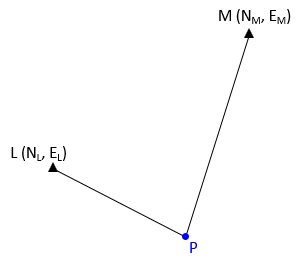Chapter B. Intersections
1. Solving point positions
a. Connecting an unknown position
A point whose absolute position is to be determined has two unknowns: North and East. To solve both unknowns requires two measurements connecting the point to a set of known coordinates. In the case of a point-to-point forward computation, the unknown point is connected with a length and direction to a single known point, Equations A-1 and A-2.
The two measurements don't have to be from a single point. In Figure B-1, the coordinates of points L and M are known, point P's are not.
|
|
|
Figure B-8 |
The forward computation Equations A-1 and A-2 can be written for point P from points L and M:
| Equation B-1 | |
| Equation B-2 |
Equations B-2 and B-8 have four unknowns: LLP, DirLP, LMP, and DirMP.
b. Intersections
To solve the position of point P, it must be connected to points L and M using one of the following combinations:
- LLP and DirMP
- DirLP and LMP
- LLP and LMP
- DirLP and DirMP
These are the standard COGO intersections since point P is at the intersection of two measurements. There are three intersections based on the type of measurements:
- Distance-direction (or Direction-distance, we'll use these interchangeably)
- Distance-distance
- Direction-direction
Fixing two of the measurements allows solution of the other two. For example, given the coordinates of points L and M, and the azimuths from both to point P:
| Point | North (ft) | (East) | Azimuth to P |
| L | 614.80 | 2255.90 | 117°22'40" |
| M | 791.53 | 2517.03 | 198°10'30" |
Equations B-1 and B-2 can be written as:
| Equation B-3 | |
| Equation B-4 |
These can be solved simultaneously for LLP and LMP. Either distance can then be substituted back into its respective side of Equations B-3 and B-4 to perform a forward computation to point P.
The problem is that while a direction-direction intersection is relatively easy to solve simultaneously, the other two types are not. The two equations for a direction-distance intersection will contain the sine and cosine of one unknown direction; distance-distance intersection equations will contain the sine and cosine of two unknown directions. Because sine and cosine functions are non-linear, these are not trivial solutions.
So how do we go about solving direction-distance and distance-distance intersections?
d. Solution Methods
For manual solutions, there are two general ways to solve COGO intersections:
- Triangle-based
- Arc-based
For both, we'll look first at its underlying geometry then how it's applied for the different types of intersections.
2. Intersection limitations
In basic COGO intersections there are just enough measurements made to solve for the unknown location: two measurements to solve two unknowns. An error in one or more measurement will not be apparent in the computations unless the error results in an impossible geometry condition. While COGO provides powerful computational tools, they can't make up for bad or erroneous data. The surveyor should always include additional measurements in order to provide an independent check.
